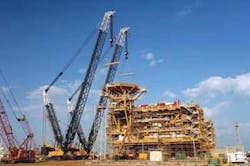French welding team ensures Dolphin development meets safety goals
Construction of Qatar’s Dolphin Gas development platforms and pipelines is nearing completion. French welding specialists Institut de Soudure (IS) supervised implementation and inspection of the welding processes, also training local personnel at the various on- and offshore sites.
The Dolphin consortium comprises Mub-adala Development Co., acting on behalf of the government of Abu Dhabi, and Total and Occidental Petroleum.
This latest development of Qatar’s offshore North field includes two new platforms, exporting a gas-condensate wellstream through two 80-km, 36-in. pipelines to a new processing complex in Ras Laffan City. From there, dried, clean gas will head south-east through a new 380-km, 48-in. submarine trunkline tracking the coast of the Arabian Peninsula, and terminating in Taweelah, north of Abu Dhabi (seeOffshore, March 2006, page 30).
Following recommendations from specialists at Total’s material and corrosion, welding, and non-destructive testing division in Paris, IS was brought onboard the Dolphin project. According to IS’ Jean Launay, who has managed contractual discussions with the Dolphin partners, “Other welding organizations approached could not offer the same level of commitment - they were proposing hiring freelancers, as opposed to offering dedicated specialists - nor did they possess the full range of expertise to meet the Dolphin project’s pre-determined specifications.
“For the welding, Dolphin Energy’s main concerns were safety, and the need to apply the most innovative technologies available. As a result, the decision was taken to minimize use of radiography for control of the welds, which can have harmful consequences for personnel exposed to handling radiographic elements in limited spaces, such as pipelay barges.
“To this end, Institut de Soudure qualified the automated ultrasonic testing (AUT) technique deployed by the pipelay contractor, thereby avoiding use of x-ray radiation onboard Saipem’sCastoro 6 and Castoro 2 laybarges. IS has also qualified time of flight diffraction (TOFD) techniques to replace radiography in pipework assembly at the onshore complex. It is now extending this qualification to thin wall thickness pipes, which would represent a first in the oil and gas sector.”
TOFD qualification in Qatar has been supported by non-destructive testing specialists flown in from IS’ headquarters near Charles de Gaulle Airport, north of Paris. IS has also supervised qualification of pipeline welding techniques, and AUT, at Saipem’s workshop in Italy. Qualification was based on Total’s internal specification, with IS’ support.
Dedicated mechanical and welding engineers, metallurgists, materials specialists, and team leaders have been working full-time at the various construction centers since the project got underway in 2003. Initially, IS specialists supervised fabrication of the offshore pipe sections at the Sumitomo and Nippon steel mills in Japan, also managing the associated inspection team.
“The steel employed for the pipelines to the treatment plant (sealines) and from there to the UAE (export lines) is basically the same X65 grade,” says Mohammed Benzaria, general manager of IS’ local branch in Qatar. “However, the sealines transporting the untreated wellstream are different, in that they have been designed to withstand a highly corrosive, biphasic environment.”
From 2004, IS began supervising engineers at J Ray McDermott’s yard in Jebel Ali, Dubai. Also that year, IS was delegated to manage all welding issues related to installation of the three offshore pipelines, including supervising laying onboard the two laybarges.
During 2005-06, IS has also been employed at Ras Laffan, both on the TOFD program, and in assisting auditing of pipework prefabrication, supplying feedback to improve productivity and the rate of repairs. The Paris laboratory recently completed corrosion testing to validate selection of a specific material for use in the treatment complex’s corrosive environment.
Prior to Dolphin, IS’ main experience for oil and gas projects arose from work for Total, Elf, or the main French service contractors. It now wants to extend its profile in this sector beyond France, in the Middle East/Caspian regions in particular.
Qatar will serve as a springboard for this ambition. IS plans to replicate its activities in France, partly through the Qatar Science and Technology park, where several majors and universities have R&D branches. Initially, it will mainly employ French ex-patriates, but it also plans to recruit and train locals, North Africans, Indonesians, and other nationalities at Qatar’s own Institute of Welding.
“We will focus in Qatar on high technology techniques and R&D in NDT, as a priority eliminating use of radiographic sources to control welds,” says Andre Protin, IS’ director for foreign business. Another goal is to encourage the Qatari regulatory authorities and oil and gas field operators in the region generally to implement European and ISO standards for welding and NDT.

